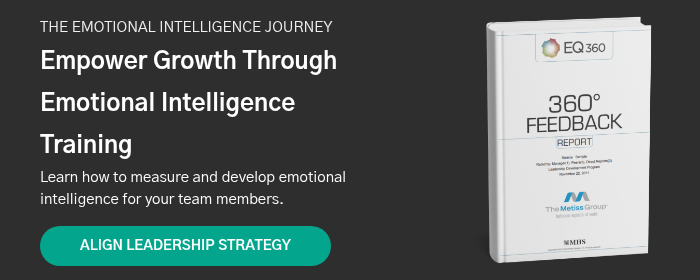
For decades, emotional intelligence (EQ) was regarded as a pleasant but largely irrelevant soft skill—a characteristic better suited for social harmony than high-stakes leadership. This view has shifted dramatically.
Today, entities known for their precision, discipline, and operational rigor—the U.S. Secret Service, federal and state law enforcement agencies, and multiple branches of the military—have integrated emotional intelligence development into their leadership training programs.
These organizations operate in environments where performance gaps carry significant consequences, yet they consistently see meaningful returns from investing in EQ development. The question is no longer whether emotional intelligence matters in leadership, but rather how it influences the decision-making process.
As the field of emotional intelligence has matured, its framework has expanded to include competencies that directly affect decision-making and stress tolerance. Historically, EQ models emphasized self-awareness, emotional expression, and interpersonal skills.
The expanded framework described in The EQ Edge by Steven Stein and Howard Book introduces critical competencies in decision-making that have profound implications for leaders navigating complex environments. This article will examine three subscales within the decision-making competency: problem solving, reality testing, and impulse control.
In this article, you will learn:
- Problem Solving: Navigating Emotionally Charged Decisions
- Reality Testing: Seeing Situations Clearly, Not Emotionally
- Impulse Control: Why Composure Is a Leadership Superpower
Problem Solving: Navigating Emotionally Charged Decisions
At its core, problem solving within the context of emotional intelligence is not simply about arriving at a solution. Stein and Book define it as the ability to find solutions in emotionally charged situations, recognizing how emotions influence both the process and the outcome. Effective problem solvers exhibit conscientiousness, discipline, and perseverance. They are methodical in their approach and understand that emotions—both their own and others’—shape the context in which decisions are made.
Leaders frequently underestimate how the emotional impact of their decisions affects organizational culture and morale. The method by which a decision is implemented can either preserve trust or erode it entirely. Consider the infamous example of KMart's corporate layoffs. Just days before Christmas, employees were informed of their termination through an abrupt and impersonal process.
Security personnel arrived at each desk, handed affected employees empty boxes, supervised the packing of personal belongings, and escorted them from the premises. The public backlash and internal resentment that followed were more damaging than the layoffs themselves. The absence of emotional consideration in how the decision was executed compounded an already difficult situation, creating a lasting negative perception that extended far beyond the initial event.
The emotional state of the decision-maker also plays a pivotal role. Leaders facing difficult choices often carry their own emotional burdens. Suppose a leader must lay off a long-standing employee who has become a personal friend. Conventional advice might suggest removing emotion entirely to maintain objectivity.
However, ignoring these feelings can lead to procrastination, avoidance, or internal distress, all of which compromise effective problem solving. Acknowledging and managing one's emotional response allows for both objective evaluation and timely, compassionate action.
Reality Testing: Seeing Situations Clearly, Not Emotionally
Reality testing is the discipline of confronting situations as they are, rather than as one fears or wishes them to be. According to The EQ Edge, it requires a search for objective evidence to support or challenge perceptions and assumptions. This skill is particularly critical in modern communication environments, where soundbites and fragmented information often distort reality.
For example, consider a scenario where a new employee receives a weekend text from their supervisor requesting a call before Monday morning. Lacking reality testing, the employee may spiral into anxiety: fearing termination or assuming some grave error has occurred.
However, if the employee reflects on their recent performance—positive feedback, successful onboarding, and strong early rapport with the team—they would recognize that such fears are unfounded. In reality, the supervisor may simply need assistance with a minor task for Monday’s meeting.
The absence of reality testing fuels unnecessary workplace tension, misinterpretations, and strained relationships. When employees and leaders consistently evaluate situations objectively, collaboration improves, innovation flourishes, and productivity increases. A workplace grounded in reality testing reduces the emotional volatility that undermines organizational cohesion.
Impulse Control: Why Composure Is a Leadership Superpower
Impulse control is the ability to resist or delay the urge to act on emotional impulses. As defined by Stein and Book, it involves avoiding rash behaviors, maintaining composure, and restraining aggressive or irresponsible actions. Within the decision-making composite scale, impulse control serves as a stabilizing force, ensuring that emotional reactions do not dictate professional conduct.
Returning to the earlier example, imagine if the employee receiving the weekend text allowed panic to govern his response. Instead of pausing to assess the situation, he might prematurely resign, believing he was about to be terminated. This reaction, driven by poor impulse control, would have led to unnecessary career disruption and potential reputational harm.
Impulse control empowers individuals to pause, evaluate, and apply logic before responding to emotionally charged stimuli. For leaders, this competency is particularly valuable when managing conflict, delivering difficult feedback, or navigating crises. Without it, decision-making becomes reactive and unpredictable, eroding trust within the leadership team and broader organization.
Building EQ for Better Leadership Decisions: Tools and Strategies
The integration of emotional intelligence into leadership development programs offers organizations a structured pathway to enhance decision-making at all levels. Tools such as the EQ360 assessment provide comprehensive insights by gathering feedback from supervisors, peers, subordinates, and even personal contacts. Guided by a certified coach, leaders can better understand their strengths, identify imbalances between subscales, and craft actionable development plans.
Leadership and development initiatives that incorporate emotional intelligence training produce leaders who are not only capable of making sound decisions but also adept at navigating the emotional complexities that accompany those decisions. Strategic leadership requires more than technical expertise; it demands the emotional competence to balance objectivity with empathy, decisiveness with patience, and confidence with humility.
Emotional Intelligence at Work: Organizational Benefits You Can Measure
Imagine a workplace where emotional intelligence is not viewed as optional, but essential. In such environments, leaders demonstrate strong problem-solving capabilities that account for both operational and human factors.
Teams communicate with clarity, minimizing misunderstandings and reducing unnecessary conflict. Employees exercise impulse control, fostering stability even during periods of uncertainty or rapid change.
The return on investment for developing emotional intelligence is measurable. It translates into improved leadership skills, stronger employee performance, higher engagement, and reduced workplace bullying. Ultimately, organizations that prioritize emotional intelligence development are better equipped to face the demands of modern business environments with resilience and clarity.



